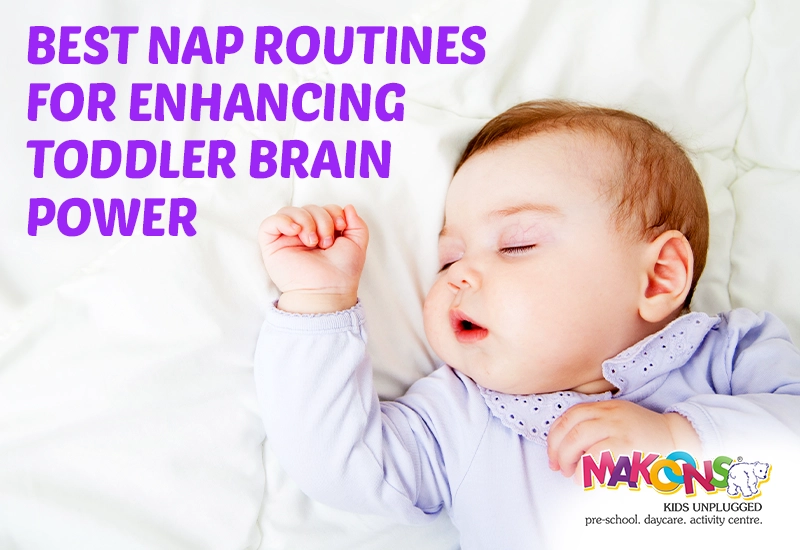There are times when children act cranky, not because they want to, but because they just don’t know how to express themselves about not missing their naps. Things like naps should have a proper routine that needs to be followed by parents and children. This will make things a lot easier. This blog will help you with the best nap routines for your child.
Why Naps Are Brain Food for Toddlers?
When toddlers sleep, their brains operate tirelessly on things that help them grow and learn. They learn things in the morning and then remember them during their naps. We organise our toy boxes this way to avoid forgetting things and crucial information later.
Kids need more than just a break during naps. Many studies indicate that Naps enhance memory power, Level of focus, as well help the child remain calm and balance the emotions accordingly, as the situation.
Understanding Your Toddler’s Sleep Needs
You should know that infants aged 1-3yrs needs at least a minimum of more than 10 hours of sleep. This is a combination of nighttime sleep and afternoon naps. As children grow, their sleep needs change; each child is a different case. A good sleep schedule for kids usually follows:.
- One afternoon nap lasting 1-3 hours.
- Bedtime between 7 and 8 PM
- Morning time between 6-7 AM
Creating the Perfect Nap Environment
You must ensure the right things are in place to help little people nap well. The place where your child naps should be:
Dark and Quiet: The curtains in black colour will help to make the room darker, as well as the noise machine or maybe a noise-free environment will help the child to sleep faster.
Cool and Comfortable: Well room temperature should be set accordingly to the weather. Dress your baby in something cozy and in more comfortable pieces of clothing.
Safe and sound: We recommend you use the same crib and feed crib for naps and nighttime sleep, which will reinforce sleep associations.
The Power of Timing
Napping when needed is so important to a toddler’s fragile brain development. A toddler’s circadian rhythm is suitable for a nap from 12:30 to 1:30 p.m. It’s perfect timing for not wrecking their evening sleep routine and has significant gains for their development.
These are signs of sleepiness that might signal when your child needs some shut-eye:
- Rubbing the eyes or yawning
- Becoming fussier or clingier
- Becoming slower
- Lack of interest in playing
Missing regular naps will affect the child’s behaviour and will create hindrances to good sleep.
Building a Consistent Routine
Being consistent means making the body know what to expect next, so that it will help the body to be prepared. This helps in making the child follow a structured routine:
Observe this simple pre-nap routine:
Step 1 Quiet Time (5 minutes) Begin with silent activities, such as reading a book or a quiet song. Restrict thrilling games or television before bed.
Step 2: Physical Preparation (5 minutes) Well, this is common sense to actually remove the diaper before sleep, and make the child wear something comfortable.
Step 3: Wind Down (5-10 minutes) Make the room darker, create the environment of sleep, and have some chit chat in the sleep area.
How Naps Make You Learn?
It’s incredible how sleep affects how toddlers learn. Your child’s brain reinforces the neural pathways that were made while they were awake during naps. Memory consolidation is the process that makes it possible to learn new abilities.
Kids who take naps often get better at:
- Language development
- Motor skills
- Emotional regulation
- Creative thinking
- Problem-solving abilities
Common Nap Challenges and Solutions
“My toddler refuses to sleep.” There are situations when a child can be tired but not tired enough to fall asleep. Then maybe you can arrive a little earlier or maybe check after, depending on what the situation needs.
“Naps are too short.”Interestingly enough, 20 to 30 minutes never really refreshes enough for the human brain. Consider turning off the lights in the room or permitting the children some quiet time prior to nap time.
“My child is cranky after naps”: This generally means that they awaken halfway through their sleep cycle. So in addition to sleeping more at night, maybe sending the child for longer naps during the day or pushing bedtime for later would work.
The Long-Term Benefits
Well, learning the habit of following your nap routines may help your child in ways that you cannot think of. They will not be annoyed or feel tired throughout the day and will be able to keep themselves calm.
As you know, children are different from one another. Different toddlers may respond to various approaches.. Finding the optimal sleep pattern for toddlers that works for your family may take time and effort.
Final Thoughts
One of the best brain-building exercises for your toddler is to have a regular nap schedule. In return for other processes, naps offer many methods other than sleeping. Well, go slowly, take little steps, habits take time to become one. With time, numerous good doses will create a happy, bright, and well-rested child. Naps give your toddler a lifetime’s worth of dividends in learning.
Read Aslo:- Top 10 Common Toddler Behavior Problems and How to Handle Them

